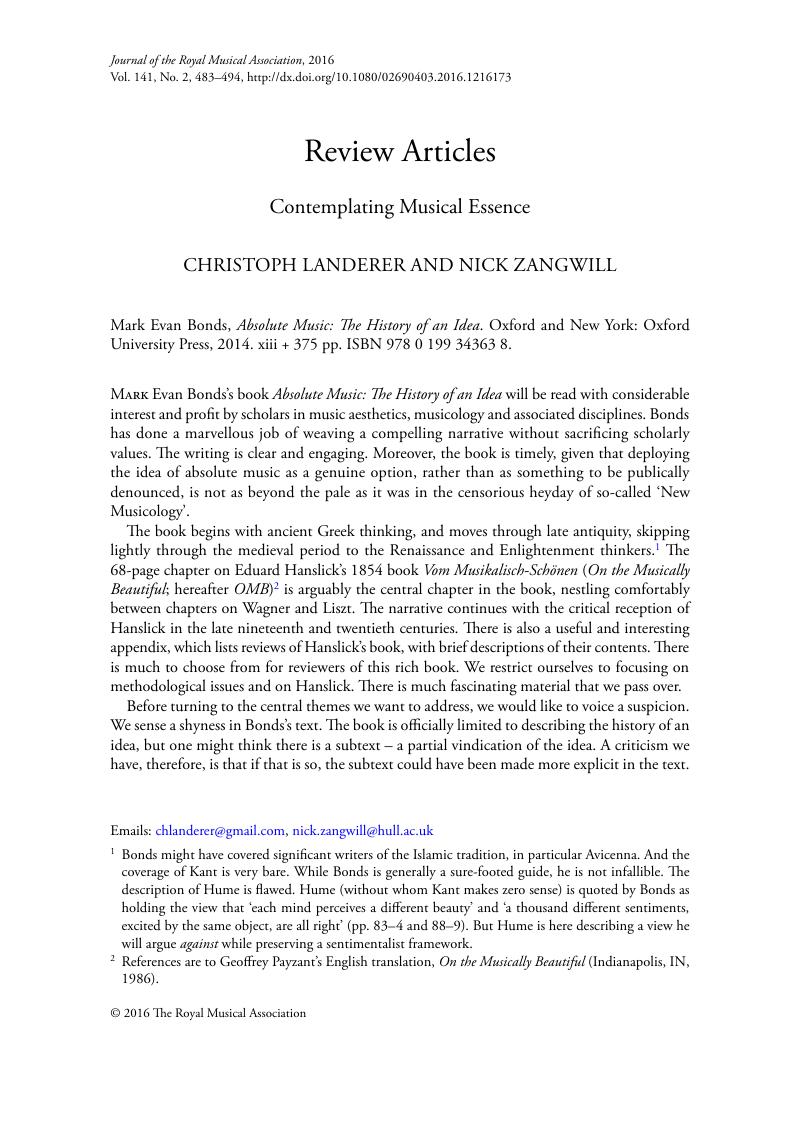Article contents
Contemplating Musical Essence
Review products
Published online by Cambridge University Press: 01 January 2020
Abstract

- Type
- Review Articles
- Information
- Copyright
- Copyright © 2016 The Royal Musical Association
References
1 Bonds might have covered significant writers of the Islamic tradition, in particular Avicenna. And the coverage of Kant is very bare. While Bonds is generally a sure-footed guide, he is not infallible. The description of Hume is flawed. Hume (without whom Kant makes zero sense) is quoted by Bonds as holding the view that ‘each mind perceives a different beauty’ and ‘a thousand different sentiments, excited by the same object, are all right’ (pp. 83– 4 and 88–9). But Hume is here describing a view he will argue against while preserving a sentimentalist framework.
2 References are to Geoffrey Payzant's English translation, On the Musically Beautiful (Indianapolis, IN, 1986).
3 Daniel Chua, Absolute Music and the Construction of Meaning (Cambridge, 1999).
4 Susan McClary, ‘Narrative Agendas in “Absolute” Music: Identity and Difference in Brahms's Third Symphony’, Reading Music: Selected Essays (Aldershot and Burlington, VT, 2007), 65–83; originally published in 1993.
5 Sanna Pederson, ‘Defining the Term “Absolute Music” Historically’, Music and Letters, 90 (2009), 240–62 (p. 240; her emphasis).
6 Carl Dahlhaus, The Idea of Absolute Music (Chicago, IL, and London, 1989); originally published in German in 1978.
7 See Andrew Barker, The Science of Harmonics in Classical Greece (Cambridge, 2007).
8 See ‘Hanslick's Deleted Ending’, our contribution to a symposium on Bonds's book in the British Journal of Aesthetics, forthcoming.
9 Robert Zimmermann, ‘Vom Musikalisch-Schönen’, Zur Aesthetik: Studien und Kritiken (Vienna, 1870), 239–53.
10 Gottlob Frege, ‘Sense and Reference’, Philosophical Review, 57 (1948), 209–30; originally published in German in 1893.
11 Ludwig Wittgenstein, Philosophical Investigations (Oxford, 2008); originally written in the late 1930s. See especially sections 65–71.
12 See, for example, Kevin Karnes, Music, Criticism, and the Challenge of History: Shaping Modern Musical Thought in Late Nineteenth-Century Vienna (Oxford and New York, 2008).
13 Chua, Absolute Music, 228.
14 Ibid.
15 Geoffrey Payzant, ‘Essay: Towards a Revised Reading of Hanslick’, OMB, 93–102 (p. 101).
16 Ibid., 95.
17 Johann Friedrich Herbart, Kurze Encyklopädie der Philosophie aus praktischen Gesichtspuncten entworfen, ed. Gustav Hartenstein (Leipzig, 1850), 111 (§ 71); translation by Lee Rothfarb.
18 The German original has ‘dieser Klanggattung’ where Payzant's translation has ‘sonority’. A more literal translation might refer to a ‘specific genre of sound’ instead of Payzant's ‘sonority’.
19 Payzant's phrasing ‘purely musical directions’ is not quite correct. ‘Züge’, the word used by Hanslick, might be best translated as ‘features’.
20 Karnes, Music, Criticism, and the Challenge of History, 52.
21 Geoffrey Payzant, ‘Hanslick on Music and Time’, Hanslick on the Musically Beautiful: Sixteen Lectures on the Musical Aesthetics of Eduard Hanslick (Christchurch, 2002), 120–8 (pp. 127–8).
22 See above, note 9. Rudolf Schäfke was the first to make this observation, in Eduard Hanslick und die Musikästhetik, Sammlung musikwissenschaftlicher Einzeldarstellungen, 1 (Leipzig, 1922).
23 ‘Denn das Schöne beruht auf sich gleich bleibenden Verhältnissen.’ For this observation, see Hartmut Grimm, ‘Zwischen Klassik und Positivismus: Zum Formbegriff Eduard Hanslicks’ (Ph.D. dissertation, Humboldt University of Berlin, 1982).
24 Barbara Titus, ‘The Quest for Spiritualized Form: (Re)positioning Eduard Hanslick’, Acta musicologica, 80 (2008), 67–98 (pp. 82ff.).
25 See, for example, Friedrich Theodor Vischer, Ästhetik oder Wissenschaft des Schönen, 10 vols. (Reutlingen, Leipzig and Stuttgart, 1846 –58), iii/1 (Reutlingen, 1851), 13: ‘Das Schöne ist […] wesentlich Erscheinung, also für ein anschauendes Subjekt’ (‘Beauty is […] essentially appearance, which is for a perceiving subject’). The context of the passage is Hanslick's introduction of the concept of ‘Anschauung’ (contemplation) that Zimmermann, in his review, regarded as rooted in Vischer.
26 The term ‘absolute music’ that Hanslick uses in the German original – ‘reine, absolute Tonkunst’ (where ‘Tonkunst’ – ‘art of tones’ – is another German term for music) – is somewhat obscured in the Payzant translation.
27 Hans Kelsen, Hauptprobleme der Staatsrechtslehre, entwickelt aus der Lehre vom Rechtssatze (Tübingen, 1911), 92.
- 1
- Cited by




